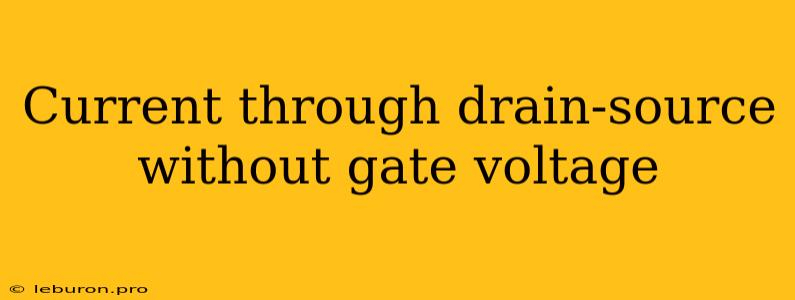Understanding the behavior of transistors is crucial in electronic circuit design, particularly in the context of their ability to control current flow. One intriguing aspect of transistor operation is the presence of current through drain-source without gate voltage. This phenomenon, while often overlooked, can significantly impact circuit performance and requires careful consideration. This article delves into the reasons behind this current flow and explores its implications, providing insights into how to mitigate or utilize this effect for optimal circuit design.
The Fundamental Operation of Transistors
Before delving into the complexities of current flow without gate voltage, it's essential to understand the basic principle of transistor operation. A transistor, fundamentally, acts as a controlled switch, enabling or limiting the flow of current between its drain and source terminals based on the voltage applied to its gate.
Depletion Mode Operation
In depletion mode transistors, the gate-source junction is reverse-biased. This reverse bias creates a depletion region within the semiconductor material, acting as a barrier to current flow between drain and source. When no gate voltage is applied, the depletion region is at its maximum, significantly limiting the current flow. However, the key point here is that even without gate voltage, there is a small current through drain-source, albeit significantly less than when the transistor is fully turned on. This current through drain-source without gate voltage is often referred to as the "leakage current."
Factors Contributing to Current Through Drain-Source Without Gate Voltage
Several factors can contribute to the presence of current through drain-source without gate voltage:
-
Reverse Leakage Current: Even in a reverse-biased junction, a small amount of current can flow due to thermally generated carriers overcoming the depletion region. This is known as the reverse leakage current, and it is always present, albeit usually very small.
-
Subthreshold Current: While the transistor is nominally "off" with no gate voltage, there is still a small amount of current that can flow due to carriers with sufficient energy to overcome the depletion region barrier. This current is known as the subthreshold current.
-
Junction Capacitance: The junction between the gate and the channel, even when reverse-biased, possesses a certain capacitance. This capacitance can contribute to a small current flow, particularly at higher frequencies.
-
Parasitic Elements: Transistors are not ideal devices, and parasitic elements such as resistance and capacitance associated with the device structure can contribute to current through drain-source without gate voltage.
Impact of Current Through Drain-Source Without Gate Voltage on Circuit Performance
The presence of current through drain-source without gate voltage, though often small, can have significant implications for circuit performance, depending on the specific application:
-
Power Consumption: In low-power applications, this current through drain-source without gate voltage, even though small, can contribute to power dissipation, especially when a large number of transistors are involved.
-
Analog Circuit Performance: In analog circuits, such as amplifiers, this current can cause unwanted offsets and contribute to noise, impacting the signal-to-noise ratio.
-
Digital Circuit Performance: In digital circuits, especially at low voltage levels, this current can cause unexpected logic transitions and lead to errors in data processing.
-
Thermal Effects: The current through drain-source without gate voltage, even though small, can contribute to heat dissipation within the device, potentially leading to thermal runaway in extreme cases.
Mitigation and Utilization Strategies
Several strategies can be employed to mitigate or utilize the effects of current through drain-source without gate voltage:
-
Device Selection: Choosing transistors with lower leakage currents and lower subthreshold slopes can significantly reduce the impact of this effect.
-
Circuit Design Techniques: Implementing techniques like current mirroring can help cancel out the effects of leakage current.
-
Biasing Strategies: Applying a small bias voltage to the gate can be used to control the leakage current and maintain the transistor in a desired operating state.
-
Temperature Compensation: Implementing temperature compensation mechanisms can help minimize the impact of temperature variations on leakage current.
-
Active Current Sources: In some cases, this current through drain-source without gate voltage can be utilized as a controllable current source, providing a useful feature for specialized applications.
Conclusion
While often overlooked, current through drain-source without gate voltage is a crucial factor to consider in transistor operation. Understanding the sources of this current and its potential impact on circuit performance is essential for achieving optimal design and performance. By implementing appropriate mitigation strategies and leveraging potential applications, engineers can harness the power of transistors while minimizing the effects of this often-overlooked phenomenon. As technology continues to advance and transistors shrink in size, understanding and managing the effects of current through drain-source without gate voltage will become increasingly important for achieving reliable and efficient electronic circuits.
